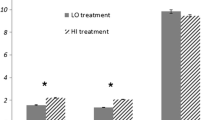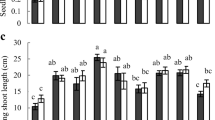Abstract
Ten fungal root endophytes were isolated from wild populations of Hordeum murinum ssp. murinum L. and inoculated onto untreated seeds of a barley cultivar using five artificial and one soil-based growth media. A co-inoculant of all ten isolates as well as two individual isolates successfully suppressed the development of seed-borne fungal infections on germinated and ungerminated seed. The two most successful isolates were also the most persistent as re-emergents and may provide real potential for development as crop inoculants. All isolates were more persistent in barley exposed to light after germination. The soil-based compost was associated with the greatest degree of seed-borne infection suppression, and the most successful artificial medium for suppressing seed-borne infections was also the medium with the most similar pH to the soil at the sampling sites. These results suggest a direct antagonistic effect of the fungal isolates on seed-borne pathogens without the induction of plant defences.


Similar content being viewed by others
References
Adame-Álvarez R-M, Mendiola-Soto J, Heil M (2014) Order of arrival shifts endophyte-pathogen interactions in bean from resistance induction to disease facilitation. FEMS Microbiol Lett 355:100–107
Barrow JR, Osuna-Avila P, Reyes-Vera I (2004) Fungal endophytes intrinsically associated with micropropagated plants regenerated from native Bouteloua eriopoda Torr. and Atriplex canescens (Pursh) Nutt. In Vitro Cell Dev Biol Plant 40:608–612
Boyd L, Ridout C, O’Sullivan DM, Leach JE, Leung H (2013) Plant-pathogen interactions: disease resistance in modern agriculture. Trends Genet 29:233–240
Chakraborty S, Newton C (2011) Climate change, plant diseases and food security: an overview. Plant Pathol 60:2–14
Consultative Group On International Agricultural Research (CGIAR) (2012). Barley. Montpellier, France: CGIAR. Available online at: http://www.cgiar.org/our-research/crop-factsheets/barley. Accessed 17 Mar 2014
Deshmukh SD, Kogel K-H (2007) Piriformospora indica protects barley from root rot caused by Fusarium graminearum. J Plant Dis Prot 114:263–268
Deshmukh S, Hückelhoven R, Schäfer P, Imani J, Sharma M, Weiss M, Waller F, Kogel K-H (2006) The root endophytic fungus Piriformospora indica requires host cell death for proliferation during mutualistic symbiosis with barley. Proc Natl Acad Sci 103:18450–18457
Dobermann A, Nelson R (2013) Solutions for sustainable agriculture and food systems: technical report for the post-2015 development agenda. United Nations Sustainable Development Solutions Network. 1–108. SDSN Secretariat, New York, USA
Duda FJ (2008) Suppression of turfgrass diseases through manipulation of soil pH. J Nat Resour Life Sci Educ 37:38–42
Lipsitch M, Siller S, Nowak MA (1996) The evolution of virulence in pathogens with vertical and horizontal transmission. Evolution 50:1729–1741
Macia-Vicente JG, Mendgen K, Lopez-llorca LV (2008) Colonization of barley roots by endophytic fungi and their reduction of take-all caused by Gaeumannomyces graminis var. tritici. Can J Microbiol 54:600–609
Mathre DE (1997) Compendium of barley diseases. American Phytopathological Society, New York, USA
Molitor A, Kogel K (2009) Induced resistance triggered by Piriformospora indica. Plant Sig Behav 4:215–216
Murphy BR (2013) Fungal infection in barley roots—friend and foe. In: Schneider C, Leifert C, Feldmann F (eds) Endophytes for plant protection: the state of the art. Deutsche Phytomedizinische Gesellschaft, Braunschweig, Germany, pp 102–116
Murphy BR, Doohan FM, Hodkinson TR (2013) Fungal endophytes of barley roots. J Agr Sci 152:602–615
Murphy BR, Doohan FM, Hodkinson TR (2014) Yield increase induced by the fungal root endophyte Piriformospora indica in barley grown at low temperature is nutrient limited. Symbiosis 62:29–39
Nelson KA, Motavalli PP, Nathan MJ (2004) The impact of foliar potassium fertilizer source on crop response and weed control in a no-till “weed and feed” glyphosate-resistant soybean production system, Vol. 21. Proceedings of the 2004 fluid forum, Scottsdale, Arizona USA, pp 149–155
Newton AC, Flavell AJ, George TS, Leat P, Mullholland B, Ramsay L, Revoredo-Giha C, Russell J, Steffenson BJ, Swanston JS, William TB, Waugh R, Waugh T, White PJ, Bingham IJ (2011) Crops that feed the world 4. Barley: a resilient crop? Strengths and weaknesses in the context of food security. Food Sec 3:141–178
O’Hanlon K, Knorr K, Jørgensen LN, Nicolaisen M, Boelt B (2012) Exploring the potential of symbiotic fungal endophytes in cereal disease suppression. Biol Control 63:69–78
Pal KK, Mc Spadden Gardener B (2006) Biological control of plant pathogens. The plant health instructor 1–25. APSnet. Available online http://www.apsnet.org/edcenter/advanced/topics/Pages/BiologicalControl.aspx
Rabbani N, Bajwa R, Javaid A (2011) Influence of culturing conditions on growth and sporulation of Drechslera hawaiiensis, the foliar blight pathogen of Marsilea minuta L. Afr J Biotechnol 10:1863–1872
Ramos HP, Said S (2011) Modulation of biological activities produced by an endophytic fungus under different culture conditions. Adv Biosci Biotechnol 2:443–449
Rengasamy P (2010) Soil processes affecting crop production in salt-affected soils. Funct Plant Biol 37:613–620
Roy JK, Smith KP, Muehlbauer GJ, Chao S, Close TJ, Steffenson BJ (2010) Association mapping of spot blotch resistance in wild barley. Mol Breed 26:243–256
Saravesi K, Ruotsalainen L, Cahill JF (2013) Contrasting impacts of defoliation on root colonization by arbuscular mycorrhizal and dark septate endophytic fungi of Medicago sativa. Mycorrhiza 24:239–245
Schäfer P, Pfiffi S, Voll LM, Zajic D, Chandler PM, Waller F, Scholz U, Pons-Kühnemann J, Sonnewald S, Sonnewald U, Kogel K-H (2009) Phytohormones in plant root-Piriformospora indica mutualism. Plant Sig Behav 4:669–671
Schulz B, Rommert A-K, Dammann U, Aust H-J, Strack D (1999) The endophyte-host interaction: a balanced antagonism? Mycol Res 103:1275–1283
Soytong K, Kanokmedhakul S, Kukongviriyapa V, Isobe M (2001) Application of Chaetomium species (Ketomium) as a new broad spectrum biological fungicide for plant disease control: a review article. Fungal Div 7:1–15
Stace C (2010) New flora of the British Isles. Cambridge University Press, Cambridge, UK
Stanojevic D, Comic L, Stefanovic O, Solujic-sukdolak S (2009) Antimicrobial effects of sodium benzoate, sodium nitrite and potassium sorbate and their synergistic action in vitro. Bulg J Agric Sci 15:307–311
Steffenson BJ, Olivera P, Roy JK, Jin Y, Smith KP, Muehlbauer GJ (2007) A walk on the wild side: mining wild wheat and barley collections for rust resistance genes. Aust J Agric Res 58:532–544
Stewart AD, Logsdon JM, Kelley SE (2005) An empirical study of the evolution of virulence under both horizontal and vertical transmission. Evolution 59:730–739
Streeter D, Hart-Davies C, Hardcastle A, Cole F, Harper L (2009) Collins Flower Guide. HarperCollins Publishers, London, UK
Unnikumar KR, Sree KS, Varma A (2013) Piriformospora indica: a versatile root endophytic symbiont. Symbiosis 60:107–113
Verma S, Varma A, Rexer K, Hassel A, Kost G, Bisen P, Bütehorn B, Franken P (1998) Piriformospora indica, gen. et sp. nov., a new root-colonizing fungus. Mycologia 90:896–903
Waller F, Achatz B, Baltruschat H, Fodor J, Becker K, Fischer M, Heier T, Hückelhoven R, Neumann C, von Wettstein D, Franken P, Kogel K-H (2005) The endophytic fungus Piriformospora indica reprograms barley to salt-stress tolerance, disease resistance, and higher yield. Proc Natl Acad Sci 102:13386–13391
White T, Bruns T, Lee S, Taylor J (1990) Amplification and direct sequencing of fungal ribosomal RNA genes for phylogenetics. In: Innis M, Gelfand D, Shinsky J, White T (eds) PCR Protocols: a guide to methods and applications. Academic Press, pp 315–322
Zadoks JC, Chang TT, Konzak CF (1974) A decimal code for the growth stages of cereals. Weed Res 14:415–421
Acknowledgments
We thank: Goldcrop Seeds, Cork, Ireland for the generous supply of barley seeds, and for advice on suitable cultivars to use; Helena Murphy for proof reading and the de-cluttering of technical terms; laboratory technicians at Trinity College Dublin for providing supplies and technical support. Trinity College Dublin provided financial support through a PhD studentship grant.
Author information
Authors and Affiliations
Corresponding author
Additional information
Handling Editor: Fouad Daayf.
Rights and permissions
About this article
Cite this article
Murphy, B.R., Doohan, F.M. & Hodkinson, T.R. Persistent fungal root endophytes isolated from a wild barley species suppress seed-borne infections in a barley cultivar. BioControl 60, 281–292 (2015). https://doi.org/10.1007/s10526-014-9642-3
Received:
Accepted:
Published:
Issue Date:
DOI: https://doi.org/10.1007/s10526-014-9642-3




